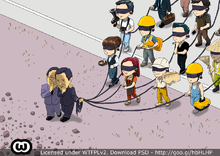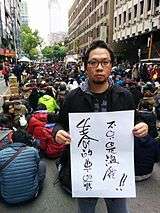Cross-Strait Service Trade Agreement
The Cross-Strait Service Trade Agreement, commonly abbreviated CSSTA and sometimes alternatively translated Cross-Strait Agreement on Trade in Services (Chinese: 海峽兩岸服務貿易協議; pinyin: Hǎixiá Liǎng'àn Fúwù Màoyì Xiéyì), is a treaty between the People's Republic of China and the Republic of China on Taiwan, signed in June 2013 but never ratified by the Taiwanese legislature, aimed at liberalizing trade in services between the two economies. Under the terms of the treaty, service industries such as banking, healthcare, tourism, film, telecommunications, and publishing would be opened to investment and businesspeople would be able to obtain indefinitely renewable visas for the other territory. It would become easier for businesses to set up offices and branches in the other territory and for large stakes in businesses to be sold to the other party’s investors.[1]
Long name:
| |
|---|---|
| Type | Service Trade Agreement |
| Signed | June 21, 2013 |
| Location | |
| Signatories | Chairman Lin Join-sane President Chen Deming |
| Parties | |
| Language | Traditional Chinese Simplified Chinese |
| Cross-Strait Service Trade Agreement | |||||||
|---|---|---|---|---|---|---|---|
| Traditional Chinese | 海峽兩岸服務貿易協議 | ||||||
| Simplified Chinese | 海峡两岸服务贸易协议 | ||||||
| |||||||

The CSSTA is one of two planned follow-up treaties to the 2010 Economic Cooperation Framework Agreement. The other, the Cross-Strait Goods Trade Agreement, has not yet been negotiated.[2]
In March 2014 the Sunflower Student Movement began. The movement opposed the CSSTA, protesting the agreement on the grounds that the Kuomintang (KMT) leadership in Taiwan negotiated and attempted ratification through undemocratic processes.
Diplomatic and legislative history
The CSSTA was negotiated and signed by the Straits Exchange Foundation, representing Taiwan, and the Association for Relations Across the Taiwan Straits, representing mainland China, on June 21, 2013, in Shanghai.[3] The leadership of the Chinese Nationalist Party (KMT) had hoped to immediately send the treaty to the legislature to be ratified, but substantial concern about the closed-door negotiations and the potential effects of the treaty among opposition lawmakers, academics, civic organizations, and ordinary citizens compelled the KMT leadership to agree on June 25, 2013, to a clause-by-clause review of the treaty and a series of public hearings on its possible effects.[4]
On March 17, 2014, after a continuing standstill in the legislature over the review process, KMT leadership asserted that the review process had exceeded the allotted time and was to be considered complete, and the CSSTA would therefore be submitted to a final vote on March 21.[4] The legality of this action is debated by experts. Public protest in response began that night, expressing disapproval of the purportedly antidemocratic behavior of the KMT as well as long-simmering discontent with the CSSTA. The protests quickly developed into the Sunflower Student Movement.
Media reports in May 2016 indicated that the new DPP government will seek ratification of the agreement in the near future based on a bill supervising cross-strait talks and agreements.[5]
Content
The text of the CSSTA, including its two appendices (“Schedules of Specific Commitments on Trade in Services” and “Specific Provisions of Service Suppliers”), is in total approximately 50 pages long.[6]
The main text enumerates rules regarding transparency requirements, administration of regulatory measures, prevention of unfair competition, an emergency negotiation mechanism, free movement of payments and capital transfers, and a principle of fair and equitable treatment.
The first appendix, “Schedules of Specific Commitments on Trade in Services,” lists service sectors or sub-sectors and related commitments on market liberalization of the two parties. The schedule is a “positive list,” meaning that service sectors or subsectors not explicitly listed in the schedule are not subject to increased opening. Up to 64 Taiwanese industries and up to 80 Chinese industries will be opened.[7] Affected industries include business services, communication services, construction and related engineering services, distribution services, environmental services, health-related and social services, tourism and travel-related services, recreational, cultural, and sporting services, transport services, and financial services. The two parties made commitments on eliminating or reducing limitations on equity participation, expanding business scope in terms of geography or lines of business, and undertaking trade facilitation measures.
Considering the controversial issue of labor movement, both sides agreed to apply the “Annex on Movement of Natural Persons Supplying Services” under the GATS to this agreement, meaning that this agreement will not apply to any governmental measures affecting natural persons seeking access to the employment market of either Party, nor will it apply to measures regarding citizenship, residence or employment on a permanent basis. However, qualified executives from China and relatives thereof may seek 3-year visas in Taiwan, and no limit is placed on the number of times the 3-year visas may be renewed.
The CSSTA includes an article to mandate future negotiations of market access on the basis of consensus. It also provides for a communication mechanism between both sides to monitor implementation.
Opposition
The CSSTA has been a subject of intense controversy in Taiwan. Advocates of the treaty argue that increased Chinese investment would provide a necessary boost to Taiwan’s economy, that the still-unspecified details of the treaty’s implementation can be worked out favorably for Taiwan, and that to “pull out” of the treaty by not ratifying it would damage Taiwan’s international credibility. The treaty’s opponents argue that the treaty would benefit large companies while devastating small and medium-sized Taiwanese businesses, that Chinese investment in the publishing industry, coming on top of currently substantial Chinese investment in the news media, would imperil free speech in Taiwan, and that the treaty would in effect lay the groundwork for eventual political unification with mainland China.[1]
More than 200 professors and industry experts have issued joint statements and held panel discussions warning the national security risks in the liberalization of the type II telecommunication services outlined in the trade pact.[8][9][10]

The chair of Economy Department in Taiwan University, Professor Zen Xiuling, pointed out that the Cross-Strait Service Trade Agreement opened 64 sectors in Taiwanese market. These 64 sectors in fact encompass thousands of businesses in Taiwan, including transportation, telecommunication, and all kinds of whole-sale/retail business that are intrinsically related to national security and the sustainability of small-to-medium businesses. Governmental officials in charge of the negotiation with China prioritize the privileged financial groups at the expense of national welfare. Opening Taiwan to China without reservation will render the island's infrastructures—both in commodity and capital circulation—to Chinese control. Sending Taiwanese specialists to China, "our economy will soon be controlled completely by China."[11] Taking example from the 5-year FTA negotiation between the US and South Korea, Zen Xiuling suggested, "the Cross-Strait Service Trade Agreement can be modified, and we demand the Legislative Yuan [parliament] to re-negotiate with China." At the public hearing for the CSSTA on July 31, 2013, Zen Xiuling reasserted her point: the Cross-Strait Service Trade Agreement opens Taiwan's telecommunication industry, whole-sale/retail businesses, and printing/publication industry to China, threatening the national security, economy, and freedom of speech in Taiwan. She therefore urged the government to renegotiate with China based on the example of the US-South Korea FTA negotiation.[12]
On May 21, Democratic Progressive Party legislators criticized the Mainland Affairs Council for classifying the disadvantages of the trade accord and releasing only information it considers favorable to the agreement. Responding to the questions, Mainland Affairs Council Minister Wang Yu-chi said that the classified information was to be used for reference only within the government. Deputy Minister of Economic Affairs Cho Shih-chao said that research produced by academics is only used for internal reference for decisionmaking. However, neither official explained why only poll numbers favorable to the government's position have been released to the public, while others were not.[13]
Public opinion
A March 2014 survey by the Taiwanese magazine Business Week indicated that 56.3% of Taiwanese opposed the treaty and 22.3% supported it. However 80.9% of those polled claimed to lack sufficient knowledge about the agreement.[14] A poll sanctioned by the Mainland Affairs Council and run by National Chengchi University in May 2014 showed a closer split in opinion, with 42.5% supporting the service agreement, and 40.1% opposing it. A majority of the people polled supported immediate deliberation and clause-by-clause review of the CSSTA, along with more transparency in the negotiation process and improved communication within the government about pacts with China, and future review of all cross-strait pacts by the Executive Yuan and National Security Council.[15] A bill intended to provide oversight on accords with China was proposed in April 2015, but did not make it to committee.[16]
Sunflower Student Movement

On March 18, 2014, protesters occupied the Legislative Yuan to raise their concern about the trade accord, which was forced to the legislative floor without proper due process. The protest, peaking at more than 500,000 people, is the largest student-led protest in Taiwan's history. Thousands of riot police from the National Police Agency were mobilized during the protests.[17]
References
- Moira Weigel, Yu-Yun Hsieh (27 March 2014). "324: Dispatch from Taipei". Retrieved 2014-03-31.CS1 maint: uses authors parameter (link)
- "Cross-Straits Economic Cooperation Framework Agreement" (PDF). ECFA. Retrieved 2014-03-31.
- Mo Yan-chih (22 June 2013). "Cross-strait service trade pact signed". Tapei Times. Retrieved 2014-03-31.
- J. Michael Cole (20 March 2014). "Taiwanese Occupy Legislature Over China Pact". The Diplomat. Retrieved 2014-03-31.
- Taiwan to continue talks with China over trade-in-goods agreement. Retrieved 2016-05-30.
- (in chinese)
- Shih Hsiu-chuan (23 June 2013). "SERVICES PACT: TSU knocks cross-strait service trade agreement". Tapei Times. Retrieved 2014-03-31.
- 服貿開發資通訊對國安的影響 (in Chinese). Slideshare. Retrieved 13 April 2014.
- 近3百位電機資訊教授連署反對服貿開放資通訊產業 (in Chinese). iThome. 10 April 2014. Retrieved 14 April 2014.
- Shan, Shelley (10 April 2014). "TRADE PACT SIEGE: Experts decry NCC telecom plans". Taipei Times. Retrieved 14 April 2014.
- 反黑箱服貿20社團上凱道. 蘋果日報. [2013-07-29] (中文(繁體)).
- 鄭秀玲, 兩岸服貿協議對我國的衝擊分析 (PDF文件). 2013-07-25
- Loa, Iok-sin (22 May 2014). "MAC hiding unfavorable data: DPP". Taipei Times. Retrieved 23 May 2014.
- Hsu, Crystal (27 March 2014). "TRADE PACT SIEGE: Majority opposes trade agreement: poll". Taipei Times. Retrieved 9 April 2014.
- Chai, Scarlet; Hou, Elaine (May 1, 2014). "42.5 percent support China services pact in gov't-backed survey". Central News Agency. Retrieved May 1, 2014.
- Tseng, Ying-yu; Tai, Ya-chen; Wen, Kuei-hsiang; Hsiao, Scully (24 April 2015). "Negotiations fail on legislative review of monitoring bill". Central News Agency. Retrieved 24 April 2015.
- Hsu, Jenny (24 March 2014). "Taiwan Police Evict Protesters From Cabinet Building". Wall Street Journal. Retrieved 30 March 2014.
External links
| Chinese Wikisource has original text related to this article: |
- Full text of the CSSTA (in Chinese)
- Full text of the CSSTA (Main Section) (in English)
- Full text of the CSSTA (Attachment 1) (in English)
.svg.png)